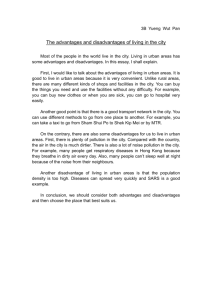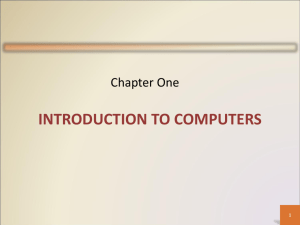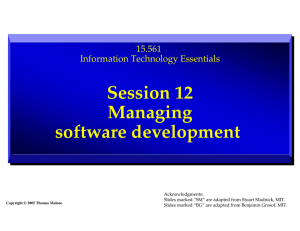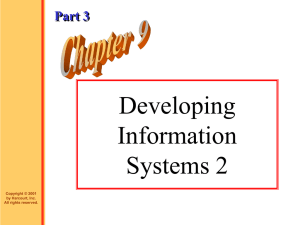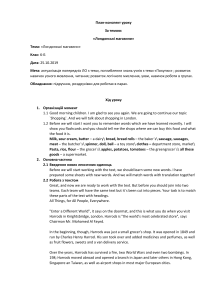1. Marketing recap - Portlethen Academy
advertisement
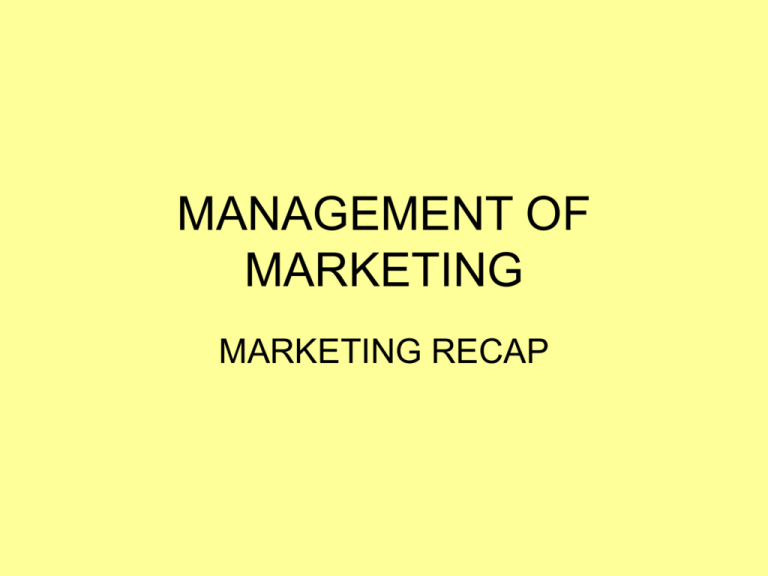
MANAGEMENT OF MARKETING MARKETING RECAP LEARNING INTENTIONS/ SUCCESS CRITERIA LEARNING INTENTIONS: SUCCESS CRITERIA: To understand the role of: • • • • • • Marketing Market Research The Marketing Mix Product Research and Development • • in the activities of an organisation • I can describe and give examples of a market. I can explain the role and importance of marketing in an organisation I can describe the methods of market research and give their advantages and disadvantages I can describe the 4 elements of the marketing mix I can describe the steps to be taken in product research and development. REMINDERS! We have learnt quite a bit about markets and the functional area of marketing already, so let’s remind ourselves of what we know so far. Answer the questions on the next slide in your jotters. QUESTIONS 1. What is a market? 2. What is the role of marketing in a business? 3. What activities are undertaken in the Marketing functional area? 4. Why is marketing important to a business? 5. Describe the marketing mix and give examples of how it works. 6. Describe the two methods of market research and give the advantages/disadvantages of each method 7. Describe the stages of Product Research and Development. ANSWER 1 A MARKET for a good or service exists when CONSUMERS (people who have money and want products) and SELLERS (people who have things to sell for money) are in contact with each other and are able to buy and sell it. SOME MARKET EXAMPLES ARE: shops, auctions, market stalls, mail order, selling via the internet (e-commerce), TV shopping channels ANSWER 2 The role of MARKETING in a business is to: • IDENTIFY the CURRENT goods and services that consumers want; • ANTICIPATE the goods and services that consumers will want in the FUTURE; • create products to SATISFY these current and future wants. ANSWER 3 Marketing activities include: Market Research Market Segmentation/Target Marketing Marketing Mix decisions, eg Product Development, Pricing, Placement and Promotion ANSWER 4 Marketing is important because if it is done properly then it can bring the following benefits: • SURVIVAL (all businesses need to satisfy their consumers or they will fail) • POSITIVE BUSINESS IMAGE (from advertising and promotions) • INCREASED CONSUMER SATISFACTION (from provision of goods and services they want) • INCREASED USE OF THE BUSINESS BY CONSUMERS (consumer loyalty) • INCREASED PROFITS, BUDGETS OR DONATIONS (from consumer loyalty) ANSWER 5 The marketing mix is the combination of the product, how it is promoted, the price it is sold at and the places where customers can buy it. This is the 4 Ps – PRODUCT, PRICE, PLACE, PROMOTION. Example – luxury products eg designer clothing, would have a high selling price, be promoted in quality magazines eg Vogue and be available for sale only in high-end retail outlets eg Harrods, House of Fraser, to attract the kind of consumers who like to buy them. ANSWER 6 Two methods of market research are FIELD RESEARCH and DESK RESEARCH. Field research involves direct contact with potential customers eg by phone, postal survey, internet survey, face-to-face survey. The advantages of this are that the information gathered is up-to-date and accurate. The disadvantages are that it is time-consuming and expensive to collect the information using this method. ANSWER 6 CONT’D Desk research involves looking at data that has already been collected for another purpose but can be used for the Businesses own purposes, eg Census, Electoral Roll, phone book, magazine articles, internet websites, competitors adverts and brochures. The advantages of this method are that the data can be found quickly and cheaply. The disadvantages are that the data may be inaccurate or out-of-date. ANSWER 7 Product research and development goes through the following stages: • Coming up with the idea/doing market research • Designing the main features of the product • Building a prototype of the product and testing it • Improving the prototype in light of test results • Test marketing the product to get customer feedback • Deciding on the correct marketing mix • Launching the product on the market



